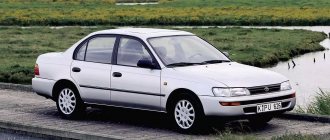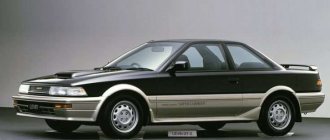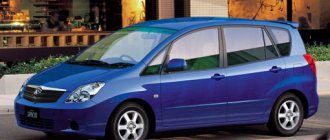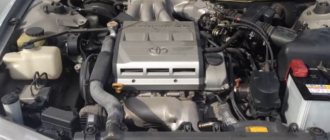Corolla Rumion configurations
The Toyota Corolla Rumion was equipped with 1.5- or 1.8-liter gasoline power units, which were equipped with continuously variable automatic transmissions, not counting the S-version, which had a simple CVT with a 7-speed shift mode. In cars of the S Aerotourer configuration, in addition to everything, speed shifters were installed on the steering column.
First generation Corolla Rumion (E150)
As for the power characteristics of the Corolla Rumion engines, the most modest of all is the 1NZ-FE engine (highest torque - 147 Nm) with its 110 hp. (at 6000 rpm).
The more powerful 2ZR-FE (maximum torque - 175 Nm) was installed on Rumion in two modifications: in the base version - with 128 hp. (at 6000 rpm) on cars manufactured before 2009; and with 136 “forces” (at 6000 rpm) - after restyling.
Rumion with the 2ZR-FAE 1.8 engine received a new generation timing belt - Valvematic, which makes the engine not only powerful, but also compliant with environmental standards.
Interior
Like all modern representatives of the Toyota Corolla model range, the car has a roomy and comfortable interior. Its interior is made in discreet gray tones and decorated with chrome inserts.
A number of successful design solutions should be noted:
- The lower line of the side windows is raised, which makes the interior not just cozy, but also protected.
- The original front panel design successfully combines rounded and horizontal lines; it seems to consist of three ergonomic zones - each is designed for specific functions.
The salon has two rows of seats. The seats feature simple adjustment mechanisms and ample front and side space for passengers.
The interior is quite functional and stylish: ceiling lighting, an audio system with nine built-in speakers, a huge number of different trays and pockets for necessary things, air conditioning, an on-board computer, an immobilizer, eight airbags, as well as other options and devices.
This Toyota representative has a spacious trunk - 310 liters, and its volume can be significantly increased due to the rear seats. The large tailgate allows for easy loading, and the carefully designed side doors ensure comfortable entry for passengers.
1NZ-FE
Power units of the NZ line began to be produced in 1999. In terms of their parameters, NZ engines are very similar to more serious units of the ZZ family - the same non-repairable block made of aluminum alloys, VVTi system at the intake, single-row timing chain, etc. There were no hydraulic lifters on the 1NZ until 2004.
Power unit 1NZ-FE
The one and a half liter 1NZ-FE is the first and basic internal combustion engine of the NZ family. It has been produced since 2000 to the present day.
| 1NZ-FE | |
| Volume, cm3 | 1496 |
| Power, hp | 103-119 |
| Consumption, l/100 km | 4.9-8.8 |
| Ø cylinder, mm | 72.5-75 |
| SS | 10.5-13.5 |
| HP, mm | 84.7-90.6 |
| Models | Allex; Allion; Auris; bB; Corolla (Axio, Fielder, Rumion, Runx, Spacio); Echo; funcargo; ist; Platz; Porte; Premium; Probox; Ractis; Raum; Sienta; Spade; Succeed; Vitz; WiLL Cypha; WiLL VS; Yaris |
| Resource, thousand km | 200+ |
Features of Toyota Rumion
The car is available in several trim levels. The basic “X” is equipped with the necessary set of equipment:
- manual air conditioning;
- central locking;
- electric windows and mirrors;
- telescopic and vertical steering wheel adjustment;
- tinted glass;
- alloy wheels;
- rear window wiper;
- fog lights.
The top-end 1.8 S package is complemented by climate control, a smart key, an engine start button, a panoramic sunroof and an aerodynamic body kit.
The Toyota Rumion car is aimed at the young and progressive generation of drivers. It is not designed for off-road use and can be used as a family car.
2ZR-FE/FAE
2ZR ICEs were launched into production in 2007. The units of this line acted as a replacement for the 1ZZ-FE 1.8 liter engine, which was criticized by many. Mainly, the 2ZR differed from the 1ZR by increasing the crankshaft stroke to 88.3 mm.
The 2ZR-FE is the base unit and the first modification of the 2ZR with the Dual-VVTi system. The power unit received several improvements and modifications.
| 2ZR-FE | |
| Volume, cm3 | 1797 |
| Power, hp | 125-140 |
| Consumption, l/100 km | 5.9-9.1 |
| Ø cylinder, mm | 80.5 |
| SS | 10 |
| HP, mm | 88.33 |
| Models | Allion; Auris; Corolla (Axio, Fielder, Rumion); ist; Matrix; Premium; Vitz |
| Resource, thousand km | 250+ |
2ZR-FAE is similar to 2ZR-FE, but uses Valvematic.
| 2ZR-FAE | |
| Volume, cm3 | 1797 |
| Power, hp | 130-147 |
| Consumption, l/100 km | 5.6-7.4 |
| Ø cylinder, mm | 80.5 |
| SS | 10.07.2019 |
| HP, mm | 78.5-88.3 |
| Models | Allion; Auris; Avensis; Corolla (Axio, Fielder, Rumion); Isis; Premium; Verso; Wish |
| Resource, thousand km | 250+ |
Exterior of Toyota Rumion
The hatchback has fairly compact dimensions: length - 4210 mm, width - 1760 mm, height of models with front-wheel drive is 1630 mm, all-wheel drive - 1640 mm. Thanks to this ratio, the car appears short, but at the same time tall.
Rumion is distinguished from other representatives of the Corolla by its original body shape. Its angularity and the predominance of straight lines are emphasized by the thin line of the radiator grille, small glass area, side mirrors and door handles painted in body color.
Typical malfunctions of Corolla Rumion engines and their causes
High oil consumption is one of the main problems of NZ engines. Usually, their serious oil burn begins after a run of 150-200 thousand km. In such cases, decarbonization or replacement of caps with oil scraper rings helps.
Extraneous noise in 1NZ series units indicates chain stretching, which also occurs after 150-200 thousand km. The problem is solved by installing a new timing chain.
Floating speeds are symptoms of contamination of the throttle block or idle air valve. Engine whistling is usually caused by a worn alternator belt, and increased vibration indicates the need to replace the fuel filter and/or front engine mount.
Also, on 1NZ-FE engines, the oil pressure sensor often fails and the rear crankshaft oil seal leaks. BC 1NZ-FE, unfortunately, cannot be repaired.
2ZR-FAE
Installations of the 2ZR series are practically no different from 1ZR units, with the exception of the crankshaft and ShPG, so typical malfunctions of 2ZR-FE/FAE engines completely repeat the problems of 1ZR-FE.
High oil consumption is typical for the first versions of the ZR internal combustion engine. If the mileage is decent, then you need to measure the compression. Unnatural noises at medium speeds indicate the need to replace the timing chain tensioner. Problems with floating speed are most often caused by a dirty damper or its position sensor. In addition, after 50-70 thousand kilometers on the 2ZR-FE, the pump begins to leak and the thermostat often fails, and the VVTi valve also jams.
History of creation and production
ATTENTION! A completely simple way to reduce fuel consumption has been found! Don't believe me? An auto mechanic with 15 years of experience also didn’t believe it until he tried it. And now he saves 35,000 rubles a year on gasoline! Read more"
It would be surprising if such a monster of the automotive industry as Toyota Motor Corporation would not experiment with the Corolla model, which is recognized by the Guinness Book of Records as the best-selling on the planet. Since 2000, the five-door Fielder station wagon, a representative of the 9th generation of Corolla cars, has been available to customers on the domestic Japanese market. The developers have shown themselves to be exceptionally productive, releasing dozens of different configurations of a convenient and very functional machine over 18 years.
The development of the appearance of the Corolla Fielder was led by a tandem - the chief designer of the Toyota Corporation, Takeshi Yoshida, and the boss of the European Design Headquarters, Luca de Meo. Everything suggests that it is too early to write off the station wagon layout as scrap. Despite the gradual transition to crossovers, a small but steady demand for long bodies still exists. But the cunning Japanese do business their own way. For 18 years, the Fielder was never released in a left-hand drive version. Only a few cars for Europe and North America in the Combi configuration with a 120 body were remotely reminiscent of this popular station wagon.
Restyling of the first generation dates back to 2004. A full-fledged change occurred in 2006. Potential buyers saw a number of new products:
- side airbags;
- closed rotation monitor;
- pollen filter in car air conditioning;
- variable speed drive;
- luminous flux regulator in headlight lamps.
In 2021, the Fielder station wagon became part of a special line of cars equipped with a special nameplate on the body for the 50th anniversary of the corporation. A regular production car was equipped with several distinctive features:
- red molding on the contour of the false radiator mesh;
- combined sports-type chairs;
- chrome-plated red inserts on the dashboard.
One of the best-selling models was the Aero Tourer package. This is a top build using an aerodynamic body kit. The rear seats can be easily removed at the driver's request in such a way that an absolutely flat two-meter platform is created for transporting goods. The entire process is carried out with one click of a mechanical handle. Another pleasant convenience is the ability to adjust the height of the steering column. This function has been carried over from the top versions of other models.
The suspension of third-generation cars with a reinforced shock absorber rod has been unified and is fully consistent with that installed on the Toyota Runx/Allex sports model. Instead of automatic transmission, they began to install a variator. Unlike the flagship model, Fielder boasts its own “charged” version – the Z Aero Tourer.
The ideal choice of motor for Fielder
One of the most modern engines for Toyota Corolla Fielder modification cars is a “graduate” of the Daihatsu engine division in 2015, 2NR-FKE. It is equipped with an updated version of the variable valve timing system – VVT-iE. The compression ratio in the engine has been brought to a very decent figure for a four-cylinder version - 13.5:1, the thermal efficiency is 38%.
The philosophy of Japanese engine builders is increasingly moving towards the abandonment of heavy 6-cylinder units in favor of environmentally friendly and lightweight in-line “fours”. The car's layout is front-wheel drive, with a continuously variable transmission (variator).
Thanks to operation on the economical Atkinson cycle, the engine produces unique fuel consumption indicators:
- in the city - 6.5 liters;
- outside the city - 4.9 l.;
- combined - 5.4 l.
The approximate running life of the engine is 200 thousand km. In addition, it is possible to combine the “efforts” of the internal combustion engine with an electric motor. In this case, the updated hybrid engine can provide even better fuel consumption characteristics - less than 3 l/100 km.
The list of main faults with this unit is very short:
- oil waste;
- fouling of collector walls with soot after 30-40 thousand km. mileage;
- short service life of the pump and ignition coils.
One of the features of the engine is its aversion to poor quality fuels and lubricants. There is no point in tuning the engine, since it will not be possible to achieve much improvement in the already excellent characteristics. The best option is careful operation and timely prevention of malfunctions.
The simplicity of the design, good service life and maintainability of the engine determine its low cost. This suggests that after a few years of active operation it can be replaced with a contract option. Mass production of the Fielder with the 2NZ-FE engine in Japan confirms that soon the flow of “used” units will move towards Siberia and the Russian Far East.











